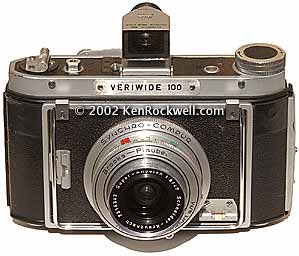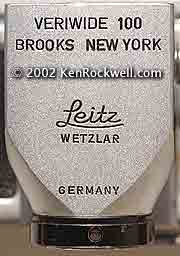Home Search Gallery How-To Books Links Workshops About Contact
Brooks-Plaubel
Veriwide 100
40 year old Brooks Veriwide. Look for used ones at Adorama.com If you've got one of these I'm still looking casually for a nice one. contact me. See how to scan these weird sizes here. INTRODUCTION This is a brilliant and compact medium format panoramic camera with a fixed 47mm f/8 lens giving seven spectacular 56 x 92mm images on a roll of common 120 film. It gives about the same angle of view as an 18mm lens on a 35mm camera. The 100 refers to the approximate diagonal angle of view in degrees. It was built from 1959 through 1965. Newer versions were called the Brooks Veriwide and instead use clumsy Mamiya 6x9 backs giving eight smaller 55 x 79 mm images on 120 film or 16 on 220 film. A newer version uses the 47mm f/5.6 Super Angulon and the newest Proshift version even added lens shifts. I'm addressing the elegant oldest version that also gives the biggest image with the smallest camera. SPECIFICATIONS Film: It puts seven healthy 56 x 92 mm images on common 120 medium- format film. Film winds backwards from right to left. That means your images read from left to right when you get your film back. Lens: 47mm f/8 Schneider Super Angulon lens, 6 elements in 4 groups. 40.5mm filter thread. Buy a step-up ring to allow use with normal filters. Five-bladed diaphragm stops from f/8 to f/32 with clicks at each full stop. Of course you may set it to any aperture. More data at Schneider Optics and here. Shutter: 1 - 1/500 second plus bulb. X Flash sync to 1/500 second. M sync for flashbulbs (remember this came out in 1959 when flashbulbs were king.). Self timer (push the sync lever to "V" after you cock the shutter). Focus: One guesses the distance and sets it on a scale calibrated from 2.3 feet to infinity, just like the Hasselblad SWC. There is no rangefinder and there is no ground glass. You focus by guessing, taping or measuring the distance with a separate external rangefinder. These external accessory rangefinders were common photo accessories before the 1960s when very few cameras had built-in rangefinders. There also are odd arbitrary metric conversions exactly at each foot marking, which is weird considering the camera and lens were made in Germany. Composition is with a special viewfinder made by Leitz marked "Veriwide 100." This finder provides the correct 1.64: 1 aspect ratio of the camera and has a reasonable safety margin built in. There is a distance adjustment on the camera's mount for the finder.
If your camera has lost the original Leitz finder shown above (worth $200 all by itself) people instead use a finder for a 20mm lens on a 35mm camera. This is OK but not really the best since the camera makes an image a bit longer and wider than the 1.5 : 1 aspect ratio of 35mm film and an ordinary 20mm finder. The Veriwide 100 has a vertical angle of view is similar to a 20mm lens on a 35mm camera and horizontally similar to an 18mm lens on a 35mm camera. There also is a folding wire finder incorporated into the body. The clever finder folds down to get out of the way. Earliest models had a single circular level on the top. Later ones have three linear levels allowing leveling for both vertical and horizontal shots. It's entirely mechanical and of course uses no batteries just like most cameras designed in the 1950s. Someone needs to tell these guys here. PERFORMANCE This is all of course limited by the lens. I've used this lens before and it's great: it's very sharp at every aperture, there is no distortion and there are no ghosts. The biggest gotcha is your ability to guess or tape focus distances and whether or not your camera hasn't been dropped in 40 years and is still aligned properly. To test this make some photos of a far away ridge of trees diagonally across the image at f/8. The entire image ought to be sharp. If one or both sides are less sharp than you've got a problem. The camera I had was pretty ratty. It was so worn I sent it right back to the mail-order dealer for a refund. 1/15 speed was really 1/30, the strap lugs were missing (the mounting holes were patched with electrical tape), the cable release socket was worn, the film advance sometimes sometimes overlapped or skipped frames, the images were soft on the left presumably from misalignment and the lens had internal haze which gave a fog effect. The images were soft overall, it had no cap, the filter thread was dinged and the cable release socket was partially stripped. Buyer beware, don't ever even think of buying one from eBay. You're dealing with a 40 year old camera so condition is everything. At least the three levels were very accurate. It has a very quiet shutter and very smooth shutter release. This makes it great for long hand-held exposures. The lens has lots of light fall-off at all apertures. This is normal for a view-camera lens. You probably want to use a center filter if you want even ilumination. This 67mm Heliopan here or 67mm Hoya here probably can be used with the step up rings mentioned below. RECOMMENDATIONS This is an unusually compact and high-performance camera that is 40 years old. Be sure to buy one you can inspect in person, NOT over eBay or the internet. Get a filter step up ring to use common sized filters. I use a 40.5mm to 52mm ring and then a 52mm to 67mm ring to allow me to use my 67mm filters with no vignetting. I'm unsure if 52mm or 40.5mm filters alone are OK. (40.5mm filters were common in 1959 and are still popular today in the motion picture industry for use behind cine lenses.) I didn't try it, however another user writes that a 40.5 -> 52mm step up ring lets him use 52mm filters with no vignetting. You have to wind the film with the wind knob AND cock the shutter for each shot separately. There is double-exposure prevention. You are in luck for film filing: my camera at least placed the frames so close together that you can squeeze two of the extra-wide 92 mm images in a standard file page cut for three frames of 6 x 6 cm. Therefore these images are very easy to file and proof one one sheet, much easier actually than the far more common 6 x 7 cm format. You'll have to screw with a flatbed or Imacon scanner for scanning. Medium format scanners like the Minolta Multi PRO only go up to 6 x 9 cm (really 55 x 84 mm) and will skip a cm of your valuable wide images. The Epson 4990 of 2005 has 6 x 12 cm holders so this might be a great one to try. Need repair? Ken Ruth knows these cameras best. A tip from Ken Ruth is to be sure to remove a locking cable release after the last frame of film, otherwise turning the advance knob may shear off an internal pin! Modern Replacements Today there are many options, all larger. See also my Linhof 617 page. I've been intrigued with the 6x12 format whose cameras provide shift. For practical use this gives you the equivalent of having shot 4 x 5" and cropping and retaining the full width. On the Veriwide with no shift you have to crop from the reduced 9 cm wide neg to replicate shift. Linhof and Horseman come to mind. The Horseman is hand holdable. Fields of View (calculated as the 35mm format lens that gives a similar field of view, presuming lenses are their marked focal length (they usually aren't) and film apertures of 24 x 36 mm for 35mm and 56 x 112 mm for 6x12.)
Horseman 6 x 12 with shift: here
with 35 mm lens ($4,900) The Horseman without shift is cheaper: here
with 35 mm lens ($3,800) Linhof Technorama 612 PC II with shift: here with 58mm lens($6,800) |





